Browsing the internet, we are often confronted with questions about cork and were it comes from. Here you can find some of those questions along with, of course, the correspondent answers and some more info we believe you will find interesting.
Where does cork come from?
Is there a cork tree?
What kind of tree does cork come from?
Where is cork grown?
How cork is made?
So… let’s try to answer all these questions in one single paragraph…
Yes, there is a cork tree! It is named Quercus Suber L but is most commonly known as the Cork Oak tree. It lives, on average, 200 years. The Cork Oak Tree is an evergreen medium-sized oak that has a thick corky bark, periodically harvested to produce marketable cork. So, cork is a natural raw material grown around the trunk of the tree, its bark actually! Yes, natural wine corks are made of bark!
Can cork oaks grow in the USA?
Where do cork trees grow?
Cork oaks can, in fact, grow in other places out of the Mediterranean Basin. However the cork they produce is not commercially suitable. In order to generate marketable cork the Quercus Suber L needs to be located in a very specific ecosystem named Montado in Portuguese and Dehesa in Spanish.
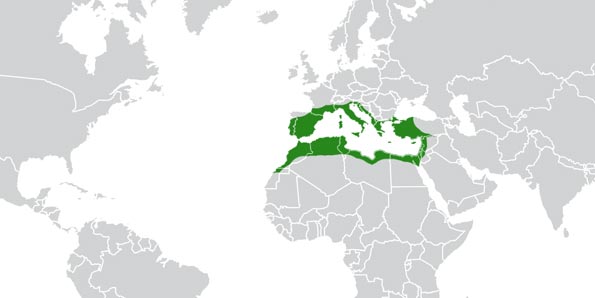
The Mediterranean Basin
How is cork harvested?
Harvesting of cork in Portugal
The cork tree should be harvested only by experienced men, which will ensure that the process will not harm nor damage the tree and according to ancestral methods that are however still current. This must only between the end of may, beginning of June and the end of August, when the cells (phelogen) responsible for its production maintains their activity and continue to divide themselves. In these conditions, cork can be extracted from the tree without damaging it. This is only possible when there is water available in the plant.
The first step is to make a vertical cut along the cork and choosing the deepest crack in the cork bark. Then the harvesters can open it by introducing the edge of the axe in the cut and twisting it so as to separate the outer from the inner bark.
The plank is then prised of the tree, with the edge of the axe being inserted between the strip and the inner bark. Thereafter, the axe is twisted between the trunk and the cork strip to be extracted.
A horizontal cut marks until where the cork plank should be removed and what is to remain on the tree. Sometimes, during this process the inner bark is marked and that can alter the geometry of the trunk.
The larger the planks extracted, the more commercial value they have, so they are very carefully removed to avoid splitting.
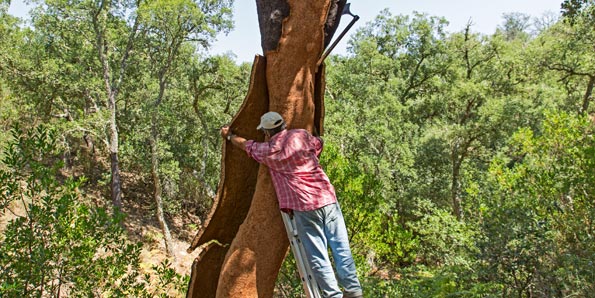
Carefully removing a big plank from the tree
After the first plank is removed, these operations are repeated on the whole trunk, and sometimes on the branches. If some cork fragments remain attached at the base of the trunk after the stripping and in order to avoid the growing of parasites in these wedges, the debarker performs the "descalce" by giving them some taps with the axe in order to remove them. (Source: APCOR)
Finally, the tree is marked using the last number of the year in which the harvesting happened. For instance, the trees harvested in 2013 were marked with a 3.
Marking a tree, harvested in 2013
How many times can a cork oak tree be harvested?
During its lifetime a cork oak can be harvested around 15 times. However, the first harvesting can only happen when the tree is 25 years and only if the trunk circumference has 70cm.
The first stripping, known as "desboia", produces a very irregular cork, too hard to be easily handled. This cork doesn't meet the quality required for cork stoppers hence will be used in other applications such as flooring, insulation, etc. It is known as the virgin cork.

Virgin cork piled after extraction
Nine years later the second harvest takes place but still produces a non-suitable material for cork stoppers, even though it is already much softer and with a more regular structure than the virgin cork. To the cork from this second harvest we call secondary cork.
Only the third and subsequent harvests will produce cork that meets the necessary standards to produce cork stoppers, since its structure is now regular with a smooth outside and inside. From here on the cork oak will supply an average of 45 kilograms of good quality cork every nine years, which can generate 3000 cork stoppers. This cork is called "amadia cork".
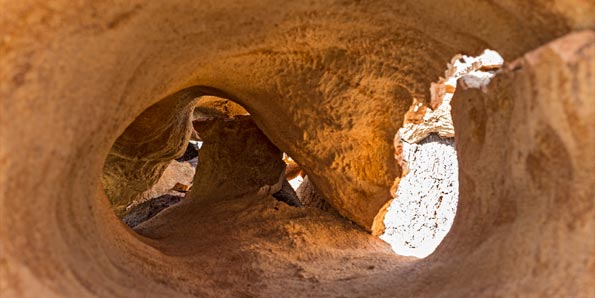
"Amadia cork" seen from the inside of a cork plank.
What is a montado?
Montado is the Portuguese term that describes a landscape with a specific ecosystem. It consists of a mix of agricultural, forestry and pastoralism fields with extensive oak woodlands in-between, planned and developed for thousands of years to assure maximum abundance from frequently ruthless and hostile circumstances, guaranteeing the lands efficiency for years to come.
With an average density of 80 trees per hectare, the montado can vary from thick forest to more open grassland and scrub vegetation areas with some trees in-between. 40% of its total area may be used as pastures and only 5% for growing cereals.
The montado is dominated by species of the genus Quercus. Although it presents large areas of holm oak (Quercus rotundifolia) and some small areas of Pyrenean oak (Quercus pyrenaica), the majority is occupied by cork oaks (Quercus Suber L). (Source: APCOR)
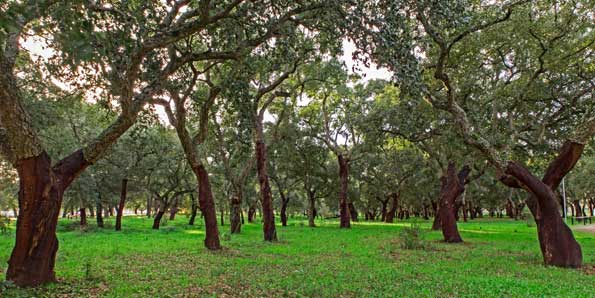
Montado
Where in the world are the montados?
The Mediterranean Basin, especially the southern regions of the Iberian Peninsula, with its dry summers and moderate winters, gathers the perfect conditions for cork forests to thrive.
Portugal, Spain, Algeria, Morocco, Italy, Tunisia and France altogether have 2.2 million hectares of cork forest. Portugal alone, in its continental territory, has over 30% of the total and, of those, 72% are found in Alentejo. (Source: APCOR)
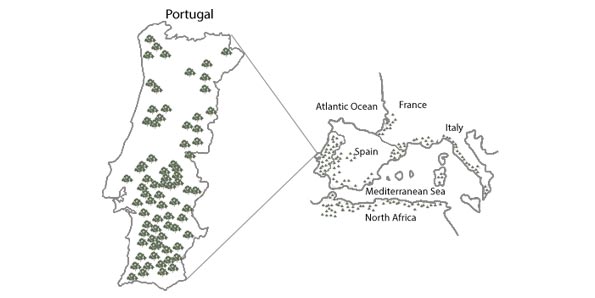
The montados in the world
How much cork is there in the world?
Due to a series of reforestation programs the areas of montado have been increasing in the recent years. In Portugal and Spain over 130 thousand hectares were planted in the last 15 years which means that the quantity of raw material obtainable will increase in the next years. (Source: APCOR)
The history of the Montado
It was millions of years ago that the first Cork Oak Trees were identified. Since then the vegetation was affected by several climatic changes. Around 1.8 million years ago, started the Pleitocene, a particularly interesting period. It was characterized by alternating periods of extreme cold, known as the glacial eras, with inter-glacial periods that were warmer. The geographical distribution and the genetic diversity of the cork oak tree were decisively influenced by these events. The Cork Oak was forced to take refuge in more benign climatic areas due to the cold, and its territorial expansion was allowed by the mildness of the inter-glacial periods. Around 10 thousand years ago, by the end of the last glacial period, the warming of the climate allowed the cork oak to colonize in its present distribution area.
Some theories defend that the cork oak tree might have used cork as an evolutionary defense from fire, an important ecological factor in that environment. The uniqueness of cork probably improved the survival of the Cork Oak throughout evolution. The physical characteristics of cork, specifically its good insulating properties, can protect Cork Oak against fire. Many of the other tree species, after a fire, only regenerate from seeds or from the tree base whilst the cork oak has the amazing ability to regenerate and recompose the tree canopy from the branches that were duly protected with its cork. Therefore, while other trees need to regenerate from the initial stage of its development, the cork oak has much less "work" making the regeneration much quicker. (Source: APCOR)
The montados biodiversity
Biodiversity includes the full range of different types of life that can be found on the earth as well as all the variations within species and ecosystems. The role and importance of both the biodiversity and ecosystems is internationally recognized as a way to diminish poverty and desertification and to support a sustainable development.
The montados play a very valuable role environmentally, ecologically and economically. They uphold rich biodiversity and a regular source of income and development opportunities in disadvantaged areas. The montados capabilities to store carbon, retain water and preserve the soil are ecological invaluable assets.
These characteristics turn the montados into one of the best Mediterranean examples for balancing between conservation and development for people and nature 's benefit.
Environmental Impact
- Carbon Sink
Global warming is commonly associated with the human act of releasing excessive amounts of greenhouse gases, such as carbon dioxide, to the atmosphere. This warming is affecting the ecosystems in a very dangerous way and, continuing like this, some of them will eventually extinguish.
With its ability to store carbon, the cork oak tree plays a very important role in reducing the greenhouse gases. Per year, each hectare of montado is able to retain around 6 tonnes of CO2 (Result of a recent study by the School of Agronomy in Lisbon).
Ctcor (Technological Centre for Cork) states that one single cork stopper is able to retain approximately the double of its own weight CO2, about 8g, whilst a vehicle releases 170g of CO2 per kilometer.
- Soil conservation
In many cases, especially in the climatic regions of the Mediterranean, the fertility if the soil depends on the organic matter, that results from the organic waste's decomposition (dry grass, leaves, branches, for example). The soil that is richer in organic matter is characterized for having better water storage, infiltration, aeration, nutrient retention and root growth capacities. In the montados' case the renewal of leaves happens annually. The old leaves together with small branches, fruits and excrements from the animals’ inhabitants of the montado, fall on the soil where they decompose contributing this way to replenish the soil with organic matter and nutrients.
The plant and animal debris' decomposition brings back up the nutrients that, in part, were caught by the roots in deeper soils. This process, which allows to herbaceous vegetation to thrive, is called translocation and is characterized by the transference of nutrients from the lower levels to the upper soil. The thin roots, that have a short lifespan and proliferate close to the soil surface, are the main contributor of organic matter in the soil. (Source: APCOR)
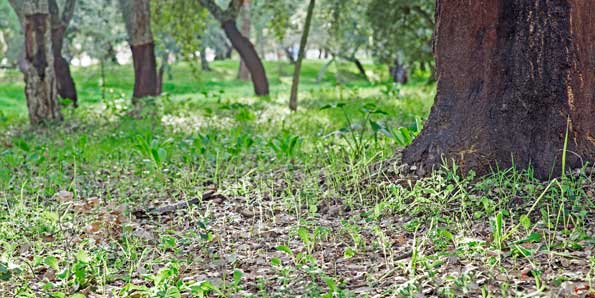
Herbaceous vegetation thriving in the montado's rich soil
Also, the evergreen treetop of the cork oak protects the soil against wind erosion and, by intercepting more than one quarter of the total precipitation, decreases the amount of water run-off, thus preventing soil erosion.
The Quercus Suber L also has a high water retention capacity due to its porosity and organic content.
- Microclimate
The microclimate created by the treetops is less extreme in winter and summer, allowing a longer growing season for the herbaceous vegetation. By reducing the wind speed they also help protecting the crops.
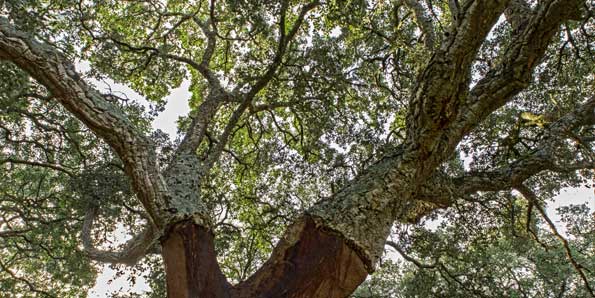
Even in the middle of winter, the cork oak treetop is green and full.
Social and economical impact
Cork is socially and economically very important for the countries of the Western Mediterranean. Due to the high market value of cork, the montados are economically sustainable as well as one of the few examples of fully sustainable forestry exploitation.
70 percent of cork’s market value is represented by bottle stoppers, although nowadays there are innumerous applications and final products.
Work in the montado is limited to the stripping season, thus mainly seasonal. Aside from the thousands of indirect jobs, the cork oak montados originate 12000 direct jobs, 6500 of which in forest exploitation.
Due to the expertise and care that it requires, the extraction of cork is the most well-paid agricultural work in the world. This centuries-old tradition combined with the most modern practices of an industry of the future help prevent the desertification of a very rural area and where there aren’t many ways to survive economically.
Desertification prevention
The sustainable land use and economic viability are the only way to prevent desertification of the rural areas. This is one of the biggest problems that humanity is facing today, being a result of natural causes or human misuse / neglect.
Cork oaks forests, an ecologically and economically sustainable system, play a crucial role in averting soil degradation, thus being an essential instrument in the battle against desertification in Portugal. The high levels of biodiversity they generate are really important in desertification prevention.
- By being an economically effective agroforestry system they hamper depopulation.
- The nutrients they extract from deeper levels are then returned to the soil as falling leaves, therefore creating fertile soil.
- With the augment of organic matter in the soil, that contributes towards greater water retention, facilitates its infiltration into the soil and reduces the losses by surface run-off, they help regulate the water cycle
From the environmental point of view and taking into account the harsh climate and poor soil, no other alternate product of cork can be this sustainable.
Some regions are only economically viable due to the wealth that cork not only creates but also distributes. There are towns where the main output is cork keeping them alive with economical and social activities.
But cork is not important only for the rural population. Residents of urban areas rely on this unique ecosystem for leisure, recreation, home and personal products and small scale agricultural production. (Source: APCOR)
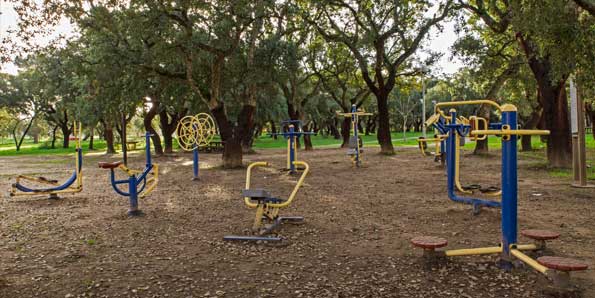
Outdoor gym inside a montado
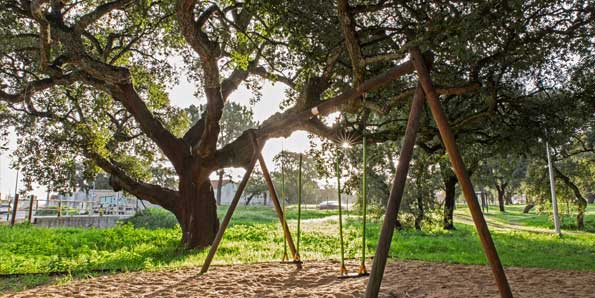
Children swing in a montado
Rural Activities
In parallel to the harvesting of cork, in these rural landscapes, some of the activities that take place include:
- Hunting and Fishing
Fishing is a favorite along the lakes of the Portuguese region Alentejo. The Achigã (Black Bass) is one of the most commonly found fish.
In the forests, partridges and wild boars can be hunted but only during the hunting season, respecting the delimited areas and obeying the applicable laws. Besides being a recreational activity, hunting is also a source of food and employment.
- Cattle Breeding
Cattling in these areas supplies the farmer with the meat used to make many certified European products, such as the pork smoked ham known and sold internationally. Being breed on the open areas of grassland and eating acorns makes the meat and milk derived from these animals to be considered superior quality.
- Herbal and medicinal plants
A large variety of food resources can be found in cork forests including herbs, seeds, fungi, acorns and wild animals, thus making a noteworthy direct contribution to the food diversity of pastoral populations.
Bees are kept for polen, honey and candle wax and are fed on lavender, heather and rock rose. The last also providing firewood for the traditional stone-built bread ovens.
The wild fungi associated with the cork oak trees are another provider of food and income. The edible mushrooms are an essential economic supplement for many families as they obtain high prices in the market.
There are many other examples of how economically valuable this natural landscape is.
- Ecotourism
Ecotourism is now defined as “responsible travel to natural areas that conserves the environment, sustains the well-being of the local people, and involves interpretation and education” (TIES, 2015)
Tourism is, then, an important source of employment in the local towns, throughout the cork forest regions, where a number of small lodges, hotels and camps prosper, and serves also as a marketing tool to draw possible inhabitants and industry to the region.
Environmental awareness is being heighten due to the small scale ecotourism that promotes nature conservation with its recreational activities, mostly outdoors, including bird watching, fishing, hunting and camping. (Source: APCOR)
Cork forests and wildlife
In an ecosystem, each organism has its own role to play. It consists of all the living things in a given area that interact with each other and also with their non-living environments. Home to a rich natural biodiversity, including grasslands, diverse flora and wildlife, and with the cork oak as the center of the food chain, the montado is the habitat for a wide variety of species of animals and plants.
The Mediterranean Basin uphold an extensive variety of habitats for fauna and flora, and is considered one of the 35 biodiversity hotspots.
- Flora
The cork oak is just one of the around 11,700 endemic plant species thriving in the Mediterranean Basin. And these are just about half of the 22.500 plant species found in this hotsopt. It is the region of the world with the third highest number of endemic plant species.
Reaching a level of 135 plant species per 1000 square meters, cork oak lanscapes are an important economic resource for local inhabitants that harvest and subsequently process these plants, many with aromatic, culinary or medical use.
Other organisms like fungi (Basydiomycetes) occur in montados. These species are important for the decomposition of organic matter in the soil. Other species, however, are pathogenic and dangerous to the montado plants. Many species are mycorrhizal - that is, they associate symbiotically with the tree roots obtaining organic carbon from the tree and helping it absorbing soil nutrients. For the Cork Oak, mycorrhizal are essential. Without them the trees would find difficulty in assimilating phosphorous and other minerals from the poor soils where they occur. Many mushrooms are edible, some having great gastronomic value. Picking mushrooms is a montado's important activity in the Iberian Peninsula. (Source: APCOR)
More than 250 species of fungi where found in cork forest, of which about one third are edible. Some of the mushrooms found in the montado are highly valuable.
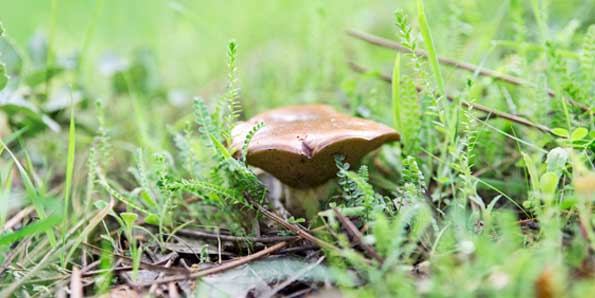
Mushroom at the montado
- Fauna
Biological and structural characteristics, in addition to high diversity of plants, give the montados the perfect characteristics for escape, cover, nidification and foraging areas for unique, some even with a protection status, species of fauna. The Iberian Lynx (Lynx pardinus), the most critically threatened feline in the world, favors the montados cork and holm oak forests as its habitat. The Imperial Eagle (Aquila adalberti), in danger of extinction, this bird of prey hunts in open areas and nidifies in the trees of the montado.
Several other species live in the montados, mostly due to the crowns that constitute an important hiding coverage all year long or shelter during nidification season. (Source: APCOR)
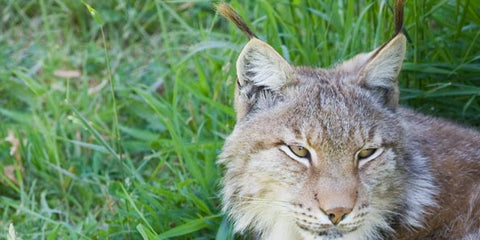
Iberian Lynx
A large diversity of insects form, in the montado, the base of a diverse feeding network. The young Cork Oak leaves are very desirable as food to some insects. Tree defoliation can even be caused, in certain areas, by some species such as the Lackey Moth (Malacosoma neustria), the Gypsy Moth (Lymantria dispar), or the Tortrix Moths (Tortrix viridiana). (Source: APCOR)
The Iberian Peninsula's cork oak forests are the ideal habitat for 24 species of reptiles and amphibians, more than 160 species of birds and 37 species of mammals and provide temporary habitat to millions of migratory birds from Northern Europe.
Protective National Legislation
In Portugal the cork oak tree is considered national heritage, and is protected by law. It cannot be cut down without a written permit from the authorities and, even so, it must be diseased, dead or really old and unproductive. As a protected tree, its harvesting is highly supervised and the rules very strict. The first harvesting can only happen when the tree reaches 25 years of age and only if the tree has at least 70cm in diameter and 130 cm in height. In the first harvest the trunk can only be stripped under a height equal to twice its perimeter. For a mature tree, in full production, the limit is three times the diameter of the trunk. The stripping of the branches is only allowed on the ones that have at least 70cm in diameter. However, under NO circumstances, can the cork oak be harvested in intervals smaller than 9 years.
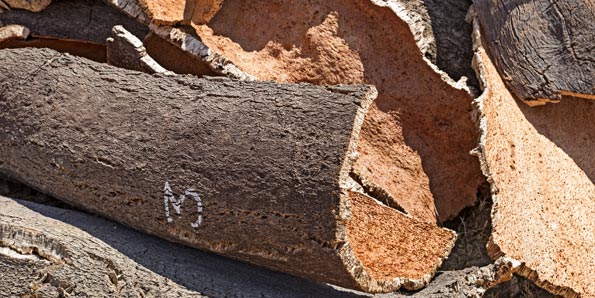
Cork harvested in 2013. This cork was left to grow for 10 years.
There are also fines protecting the cork oak forests from neglect and mismanagement and laws for the correct tilling of the soil around the tree and the correct pruning.
The first known portuguese law protecting the cork oak tree date back to the 12th century. Since 1927, when a system of rules and regulations was enforced, the laws have been updated and revised frequently. However, the protection of the tree goes way beyond legislation as many cork farmers are also members of forestry associations where there are management systems. Farmers know that a careful management of the forests enables the continued extraction of the cork bark and therefore, do not only adhere to these norms wholeheartedly but also promote them.
Reforestation Programs
Due to a series of reforestation programs the areas of montado have been increasing in the recent years. This reforestation has contributed to an annual increase of cork forest of 1% in Portugal.
In Portugal and Spain over 130 thousand hectares were planted in the last 15 years which means that the quantity of raw material obtainable will increase in the next years.
Sustainability of the cork industry
There are no losses in the cork industry. Antoine Lavoisier could be talking about cork when he wrote his famous quote "Nothing is lost... everything is transformed". All waste arising from the production of cork stoppers is transformed into useful, high quality items. Even cork dust is used for co-generation of electricity.
When one compares cork stoppers with aluminium caps and plastic closures, it is notorious that the cork stoppers possess environmental advantages in all the various indicators examined.
Greenhouse gases emission (Source: APCOR)
- Plastic closure - 10 times more CO2
- Aluminium cap - 26 times more CO2
The cork stoppers are also 100% recyclable. Even though they cannot be reused within the wine industry they can be ground up and used in the production of other agglomerated products.
The fact that no tree is cut during the harvest of cork makes it one of the most environmentally friendly raw material.
Sustainable Forest Management definition by the Ministerial Conference on the Protection of Forests in Europe (MCPFE):“The stewardship and use of forests and forest lands in a way, and at a rate, that maintains their biodiversity, productivity, regeneration capacity, vitality and their potential to fulfil, now and in the future, relevant ecological, economic and social functions, at local, national, and global levels, and that does not cause damage to other ecosystems.”

















